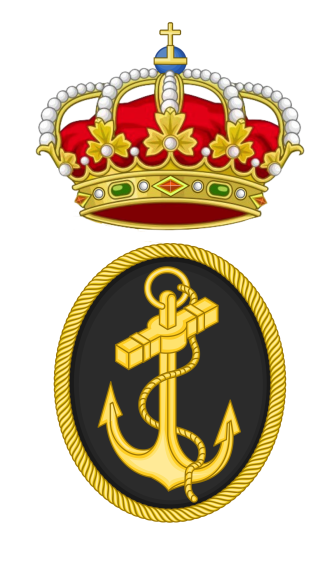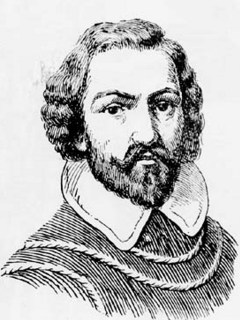
The Spanish Navy or officially, the Armada, is the maritime branch of the Spanish Armed Forces and one of the oldest active naval forces in the world. The Spanish Navy was responsible for a number of major historic achievements in navigation, the most famous being the discovery of America and the first global circumnavigation by Elcano. For several centuries, it played a crucial logistical role in the expansion and consolidation of the Spanish Empire, and defended a vast trade network across the Atlantic Ocean between the Americas and Europe, and the Manila Galleon across the Pacific Ocean between the Philippines and the Americas.

Juan Rodríguez Cabrillo was an Iberian maritime explorer best known for investigations of the West Coast of North America, undertaken on behalf of the Spanish Empire. He was the first European to explore present-day California, navigating along the coast of California in 1542–1543 on his voyage from New Spain.

The Archipelago of San Andrés, Providencia and Santa Catalina, or San Andrés and Providencia, is one of the departments of Colombia, and the only one located geographically in Central America. It consists of two island groups in the Caribbean Sea about 775 km (482 mi) northwest of mainland Colombia, and eight outlying banks and reefs. The largest island of the archipelago and Colombia is called San Andrés and its capital is San Andrés. The other large islands are Providencia and Santa Catalina Islands which lie to the north-east of San Andrés; their capital is Santa Isabel.

João Gonçalves Zarco is a Portuguese explorer who established settlements and recognition of the Madeira Islands, and was appointed first captain of Funchal by Henry the Navigator.

The Battle of San Juan de Ulúa was fought between English privateers and Spanish forces at San Juan de Ulúa. The English flotilla of six armed merchant ships under John Hawkins had been trading along the Spanish Main with the cooperation of local Spanish officials. However the central Spanish authorities considered this to be illegal smuggling that violated the Treaty of Tordesillas.

The Battle of Cádiz (1656) was an operation in the Anglo–Spanish War (1654–1660) in which an English fleet destroyed or captured the ships of a Spanish treasure fleet off Cádiz.

The naval Battle of the Abrolhos took place on 12 September 1631 off the coast of Pernambuco, Brazil, during the Eighty Years' War. A joint Spanish-Portuguese fleet under admiral Antonio de Oquendo defeated the Dutch after a six-hour naval battle.

The recapture of Bahia was a Spanish–Portuguese military expedition in 1625 to retake the city of Bahia in Brazil from the forces of the Dutch West India Company (WIC).

The Battle of Orbetello, also known as the Battle of Isola del Giglio, was a major naval engagement of the Franco-Spanish War of 1635. It was fought on 14 June 1646 off the Spanish-ruled town of Orbetello, on the coast of Tuscany, Italy, between a French fleet led by Admiral Armand de Maillé, Marquis of Brézé, and a Spanish fleet commanded by Miguel de Noronha, 4th Count of Linhares sent to break the blockade of Orbetello and relieve the town, besieged since 12 May by a French army under the command of Prince Thomas of Savoy. The Battle of Orbetello was tactically very unusual, since it was fought by sailing ships towed by galleys in a light breeze.

The Battle of Pinos was a naval engagement between a Spanish fleet under Admiral Bernardino Delgadillo y Avellaneda and the surviving ships of Francis Drake's expedition to the Spanish West Indies, now in command of Drake's lieutenant, Sir Thomas Baskerville, which took place off the Island of Pinos during the Anglo-Spanish war of 1585. The Spanish squadron was victorious, capturing two English ships.

The Battle of San Juan was a military and naval action on June 15, 1598 when an English force of 20 ships and 1,700 men under Sir George Clifford, Earl of Cumberland, overwhelmed and took the Spanish fortress Castillo San Felipe del Morro and thus took the city of San Juan, Puerto Rico. They were able to hold the castle for 65 days but disease took its toll and the English forces left, but not before sacking and burning San Juan to the ground. This was the only attack that broke through and captured El Morro castle.
The action of 12–17 January 1640 was a naval battle between a Dutch fleet and a combined Spanish-Portuguese fleet during the Eighty Years' War. The battle took place on the Brazilian coast off Pernambuco and was an attempt by a fleet consisting of approximately eighty vessels transporting about 5,000 soldiers under the command of Portuguese Admiral Fernando de Mascarenhas to land reinforcements to bolster the Portuguese militia besieging the city of Recife. On 12 January this fleet was intercepted by a Dutch task force of about forty ships commanded by Willem Loos. The ensuing battle lasted with occasional breaks until the evening of 17 January, when the Spanish and Portuguese fleet retreated and sailed away to the north.
The Battle of Vilanova took place on 17 September 1658 during the Portuguese Restoration War near the Fort of São Luis de Gonzaga, located south of Tui in the southern bank of the Minho River. A Spanish army commanded by the Governor of Galicia, Rodrigo Pimentel, Marquis of Viana, entered Portuguese territory and confronted a Portuguese army led by João Rodrigues de Vasconcelos e Sousa, 2nd Count of Castelo Melhor. The Spanish were victorious and proceeded over the following months to capture Monção, Salvaterra de Miño and other Portuguese strongholds.
The high office of Admiral of the Kingdom of Portugal as the head of the Portuguese navy was created by King Denis of Portugal in 1317 for the Genoese nobleman and naval officer Manuel Pessanha. Although there is evidence that such a title existed before, it seems to have been of only a temporary character, for fleets assembled in times of war. The exception was perhaps Nuno Fernandes Cogominho who seems to have been appointed admiral by King Denis in 1307, and still had that title at his death in 1316, although the conditions are unclear. Nonetheless, Manuel Pessanha was the first person known to hold the title of Almirante-mor as a permanent office for a permanent fleet. All the king's galleys were under his jurisdiction. The conditions of the Pessanha's title stipulated that he must maintain a corps of at least 20 Genoese naval officers at all times and was obliged to serve the king in military service on land as well as sea.

The Providence Island colony was established in 1630 by English Puritans on Providence Island, about 200 kilometres (120 mi) east of the coast of Nicaragua. It was founded and controlled by a group of English investors, the Providence Island Company.

Francisco Díaz Pimienta (1594–1652) was a Spanish naval officer who became Captain general of the Ocean Fleet.
The capture of the galleon San Joaquin or the battle of Cartagena was a naval engagement that took place off the coast near Cartagena. It involved five British ships of the line against the Spanish galleon San Joaquin and a smaller ship. After an action lasting barely an hour the Spanish ship surrendered. The galleon had fought in the previous encounter during Wager's Action nearly three years earlier but had just barely escaped capture.

The Blockade of Western Cuba, also known as the Watts' West Indies Expedition of 1591, was an English privateering naval operation that took place off the Spanish colonial island of Cuba in the Caribbean during the Anglo–Spanish War. The expedition along with the blockade took place between May and July 1591 led by Ralph Lane and Michael Geare with a large financial investment from John Watts and Sir Walter Raleigh. They intercepted and took a number of Spanish ships, some of which belonged to a Spanish plate convoy of Admiral Antonio Navarro, and protected by the Spanish navy under Admiral Diego de la Ribera intending to rid English privateers. The English took or burnt a total of ten Spanish ships including two galleons, one of which was a valuable prize. With this success and the loss of only one ship the blockade and expedition was terminated for the return to England. The blockade was one of the most successful English expeditions to the Spanish Main during the war militarily and financially.

The action off Bermuda, also known as Grenville's action off the Bermuda's, was a minor naval engagement that took place off the island of Bermuda over three days in late August 1585 during the Anglo–Spanish War between an English galleass, Tiger, and a larger Spanish galleon, Santa Maria de San Vicente. Tiger was victorious when the Spanish ship surrendered after a severe bombardment.
João Rodrigues de Vasconcelos e Sousa, 2nd count of Castelo Melhor jure uxoris, was a Portuguese military officer and colonial administrador. He was lord of Valhelhas, Almendra, and Mouta Santa, and held the offices of alcaide-mor and comendador of Pombal, alcaide-mor of Penamacor, governador das armas of the provinces of Entre-Douro-e-Minho and Alentejo, and member of the Council of War.
















